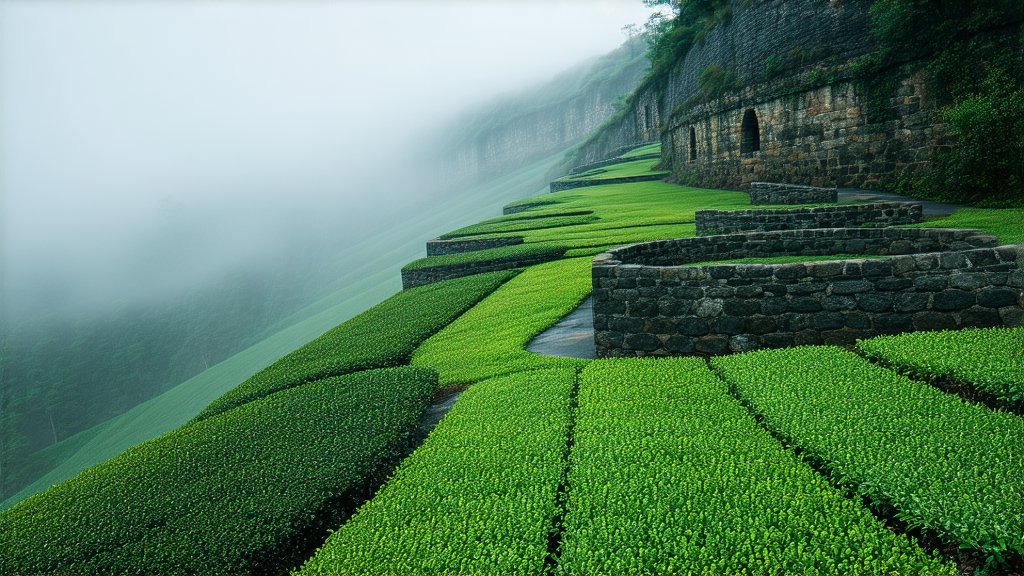
In the vast and diverse landscape of Chinese tea culture, few varieties capture the imagination and palate quite like Tieguanyin, a distinguished member of the oolong tea family hailing from the picturesque Anxi region in Fujian Province. This exquisite tea, often referred to as the "Fairy Scented Iron Goddess," boasts a rich history intertwined with legend, meticulous craftsmanship, and an unparalleled flavor profile that has earned it a revered place among tea connoisseurs worldwide.
Historical Roots
The story of Tieguanyin dates back to the early Qing Dynasty, around the mid-18th century. According to local lore, a poor scholar named Wang discovered a mysterious tea plant on a cliffside in Anxi, which he nurtured and propagated, eventually creating what would become known as Tieguanyin. Its name, translating to "Iron Weighted Buddha of Mercy," signifies the heavy, dense leaves and the compassionate nature attributed to this divine gift of nature. Over centuries, Tieguanyin evolved, adapting to its unique terroir and becoming synonymous with the art of tea making in China.
Varieties & Classification
Tieguanyin falls under the broad category of oolong teas but stands out due to its specific cultivation conditions and processing techniques. It is primarily grown in the mountainous areas of Anxi, where the mineral-rich soil and cool climate contribute to its distinctive character. There are several sub-varieties within the Tieguanyin family, each with subtle differences in aroma, taste, and appearance, such as Mi Lan Xiang (Milky Orchid Fragrance), Huang Jin Gui (Golden Osmanthus), and Rou Gui (Cinnamon). These variations arise from different microclimates, altitudes, and even the skill of individual tea masters.
Art of Craftsmanship
The production of Tieguanyin is a meticulous process that combines tradition and precision. Harvesting typically occurs multiple times a year, with spring being the most prized season for its tender leaves and vibrant flavors. Once picked, the leaves undergo a series of steps:
- Withering: Leaves are spread out to wilt under the sun or in shade, reducing moisture content and softening the cell walls.
- Brutising: Leaves are tossed or lightly shaken to further damage the cells, facilitating oxidation.
- Fixation: The leaves are briefly heated in a wok or roller to halt oxidation, preserving their greenish hue.
- Rolling: Leaves are rolled to form tight spirals, enhancing the release of flavors during brewing.
- Oxidation: Controlled exposure to oxygen allows partial oxidation, giving oolong tea its characteristic qualities.
- Roasting: Multiple rounds of roasting at varying temperatures develop the tea's complex flavors and aromas.
- Sorting & Grading: Finally, leaves are sorted based on quality, ensuring only the finest make it into premium packages.
This intricate dance between man and nature results in a tea that embodies both the essence of its origin and the artisan's touch.
Savoring the Experience
To truly appreciate Tieguanyin, one must engage not just the senses but also embrace the ritualistic aspect of tea drinking. Here's a guide to a traditional Tieguanyin tasting session:
- Preparation: Use a Yixing clay teapot or a Gaiwan for optimal heat retention and flavor expression. Rinse the leaves gently with hot water to awaken them.
- Infusion: Steep the leaves in near-boiling water (around 90-95°C) for about 30 seconds initially, gradually increasing steeping time for subsequent infusions.
- Observation: Admire the transformation of dry leaves into a vibrant emerald infusion, witnessing the unfurling of delicate leaves.
- Aroma: Inhale deeply before sipping to capture the tea's floral, fruity, or woody notes, which can vary depending on the specific variety.
- Tasting: Take small sips, allowing the tea to coat your palate fully. Notice the initial sweetness, followed by a slight astringency, and the lingering aftertaste that reveals layers of complexity.
- Appreciation: Reflect on the harmony between flavor, aroma, and texture, appreciating how each element complements the others in a balanced yet intricate composition.
Conclusion
Tieguanyin is more than just a beverage; it's an experience that encapsulates the spirit of its birthplace—a blend of nature's bounty and human ingenuity. As you delve into the world of this enchanting oolong tea, you embark on a sensory journey that transcends borders, uniting tea lovers globally in their shared appreciation for this remarkable creation from Anxi, Fujian. Whether you're a seasoned tea drinker or a curious newcomer, Tieguanyin offers a window into the profound depth and diversity of Chinese tea culture, inviting all who partake to savor life's simple yet profound pleasures.